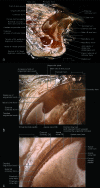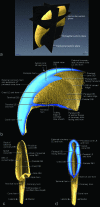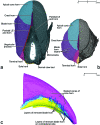The structure of the cornified claw sheath in the domesticated cat (Felis catus): implications for the claw-shedding mechanism and the evolution of cornified digital end organs
- PMID: 19422432
- PMCID: PMC2736126
- DOI: 10.1111/j.1469-7580.2009.01068.x
The structure of the cornified claw sheath in the domesticated cat (Felis catus): implications for the claw-shedding mechanism and the evolution of cornified digital end organs
Abstract
The morphology of cornified structures is notoriously difficult to analyse because of the extreme range of hardness of their component tissues. Hence, a correlative approach using light microscopy, scanning electron microscopy, three-dimensional reconstructions based on x-ray computed tomography data, and graphic modeling was applied to study the morphology of the cornified claw sheath of the domesticated cat as a model for cornified digital end organs. The highly complex architecture of the cornified claw sheath is generated by the living epidermis that is supported by the dermis and distal phalanx. The latter is characterized by an ossified unguicular hood, which overhangs the bony articular base and unguicular process of the distal phalanx and creates an unguicular recess. The dermis covers the complex surface of the bony distal phalanx but also creates special structures, such as a dorsal dermal papilla that points distally and a curved ledge on the medial and lateral sides of the unguicular process. The hard-cornified external coronary horn and proximal cone horn form the root of the cornified claw sheath within the unguicular recess, which is deeper on the dorsal side than on the medial and lateral sides. As a consequence, their rate of horn production is greater dorsally, which contributes to the overall palmo-apical curvature of the cornified claw sheath. The external coronary and proximal cone horn is worn down through normal use as it is pushed apically. The hard-cornified apical cone horn is generated by the living epidermis enveloping the base and free part of the dorsal dermal papilla. It forms nested horn cones that eventually form the core of the hardened tip of the cornified claw. The sides of the cornified claw sheath are formed by the newly described hard-cornified blade horn, which originates from the living epidermis located on the slanted face of the curved ledge. As the blade horn is moved apically, it entrains and integrates the hard-cornified parietal horn on its internal side. It is covered by the external coronary and proximal cone horn on its external side. The soft-cornified terminal horn extends distally from the parietal horn and covers the dermal claw bed at the tip of the uniguicular process, thereby filling the space created by the converging apical cone and blade horn. The soft-cornified sole horn fills the space between the cutting edges of blade horn on the palmar side of the cornified claw sheath. The superficial soft-cornified perioplic horn is produced on the internal side of the unguicular pleat, which surrounds the root of the cornified claw sheath. The shedding of apical horn caps is made possible by the appearance of microcracks in the superficial layers of the external coronary and proximal cone horn in the course of deformations of the cornified claw sheath, which is subjected to tensile forces during climbing or prey catching. These microcracks propagate tangentially through the coronary horn and do not injure the underlying living epidermal and dermal tissues. This built-in shedding mechanism maintains sharp claw tips and ensures the freeing of the claws from the substrate.
Figures















Comment in
-
'The integument story: origins, evolution and current knowledge'.J Anat. 2009 Apr;214(4):407-8. doi: 10.1111/j.1469-7580.2009.01051.x. J Anat. 2009. PMID: 19422422 Free PMC article. No abstract available.
References
-
- Al-Bagdadi F. The integument. In: Evans H, editor. Miller's Anatomy of the Dog. 3rd edn. Philadelphia, Pennsylvania: W. B. Saunders Company; 1993. pp. 98–121.
-
- Banks WJ. Applied Veterinary Histology. Baltimore, Maryland: Williams & Wilkins; 1986.
-
- Boas JEV. Krallen (inkl. Nägel, Hufe, Klauen) In: Bolk L, Göppert E, Kallius E, Lubosch W, editors. Handbuch der vergleichenden Anatomie der Wirbeltiere. Vol. 1. Berlin: Urban & Schwarzenberg; 1931. pp. 521–544. Reprinted: Amsterdam: A. Asher & Co.
-
- Bragulla H, Ernsberger S, Budras K-D. On the development of the papillary body of the feline claw. Anat Histol Embryol. 2001;30:211–217. - PubMed
-
- Bragulla HH, Homberger DG. The role of the specific, profilaggrin-containing keratohyalin granules in the developing epidermis of the fetal horse hoof. Pferdeheilkunde. 2007;23:5–20.
Publication types
MeSH terms
LinkOut - more resources
Full Text Sources
Research Materials
Miscellaneous

